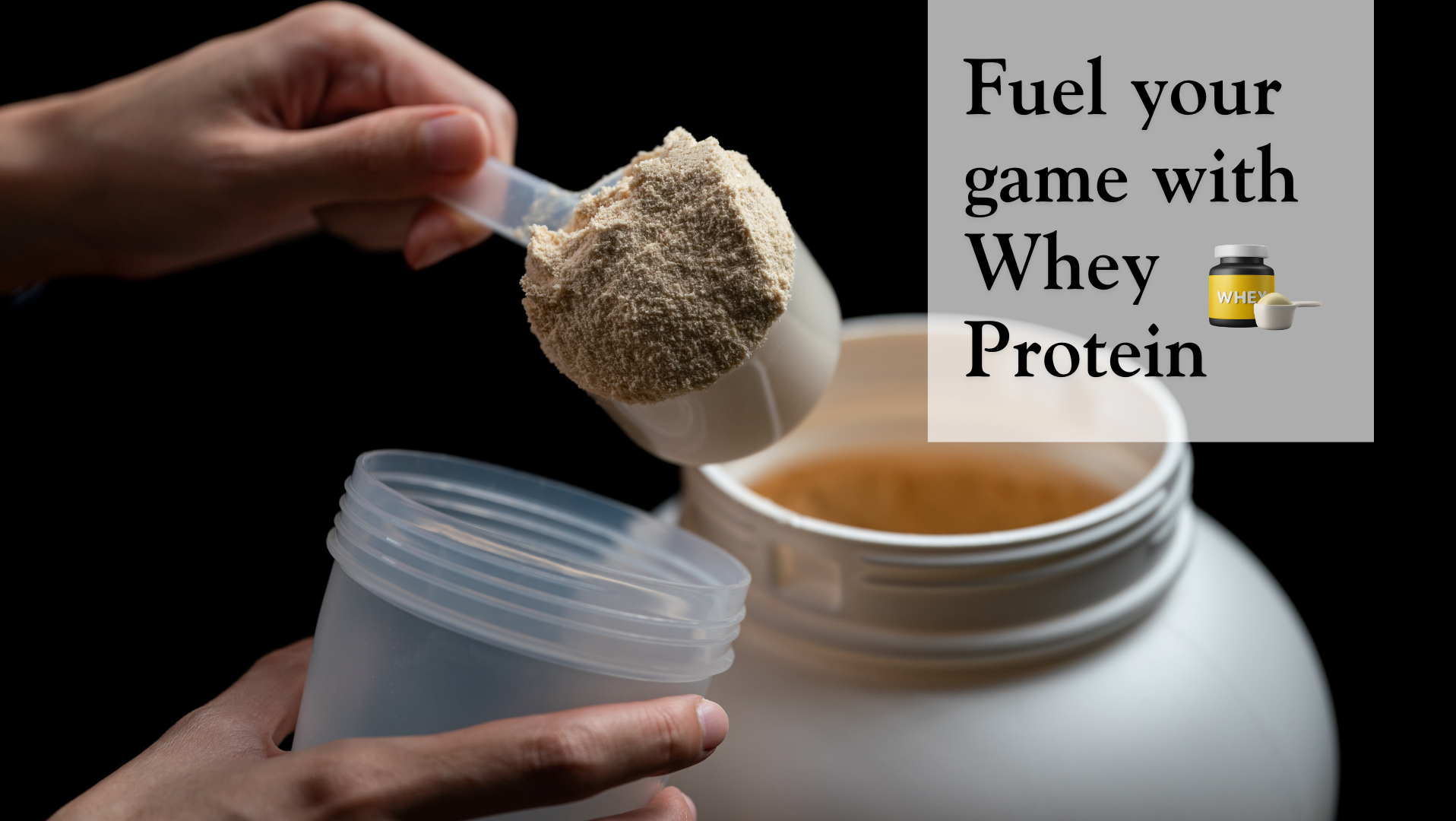
By Nutriworld | Dt. Dipanwita Saha
Sports nutrition plays a vital role in athletic performance, recovery, and overall health. Whether you’re an elite athlete, a bodybuilder, or someone engaged in regular physical activity, proper nutrition is essential for optimizing training outcomes. Among the various dietary supplements available, whey protein is one of the most popular and scientifically backed options for muscle growth, recovery, and performance enhancement. Among the many supplements available, whey protein stands out as a powerhouse for muscle growth, recovery, and overall athletic performance.
But what makes whey protein the go-to supplement for athletes? How does it aid in muscle recovery, fat loss, and endurance? In this in-depth guide, we’ll break down the science behind whey protein, its types, benefits, optimal consumption, and possible side effects—helping you make the most of your sports nutrition plan.
Introduction
Whey protein is a high-quality complete protein derived from milk. It contains all nine essential amino acids, making it superior to many other protein sources. It’s particularly rich in branched-chain amino acids (BCAAs) like leucine, which play a key role in muscle protein synthesis and recovery. When milk is processed into cheese, it separates into solid curds (casein) and liquid whey.
The whey is then filtered, purified, and dried into a protein-rich powder—which becomes the supplement we commonly see in stores.
Why Do Athletes and Fitness Enthusiasts Use Whey Protein?
✔ Rapid Absorption: Whey digests quickly, delivering amino acids to muscles faster than other proteins.
✔ Muscle Growth: High leucine content triggers muscle repair and growth.
✔ Enhanced Recovery: Reduces muscle soreness and fatigue, promoting faster recovery post-workout.
✔ Fat Loss Support: Helps preserve lean muscle mass while boosting metabolism.
Components Of Whey Protein
Whey protein is a top-tier protein known for its easy digestibility and efficient absorption. Its primary components consist of nine essential amino acids such as beta-lactoglobulin (65%), alpha-lactalbumin (25%), and serum albumin (8%). It also contains branched-chain amino acids (BCAAs) like leucine, isoleucine, and valine.
This protein is essential for promoting muscle growth, generating new tissue, and facilitating the repair of damaged tissues in the body.
Types of Whey Protein : Which One is Right for You?
Whey protein comes in three main forms, each with unique characteristics.
1. Whey Protein Concentrate (WPC)
- Protein Content: 70-80%
- Contains: Lactose, fats, and beneficial bioactive compounds
- Best For: Beginners, general fitness, and budget-conscious users
✅ Pros: More affordable, retains immune-boosting compounds
❌ Cons: Higher lactose content, may cause digestive issues
2. Whey Protein Isolate (WPI)
- Protein Content: 90% or more
- Contains: Minimal lactose and fat
- Best For: Athletes, lactose-intolerant individuals, and those on a low-carb diet
✅ Pros: Faster absorption, high protein purity
❌ Cons: More expensive, lacks some beneficial nutrients
3. Whey Protein Hydrolysate (WPH)
- Protein Content: 90%+ (pre-digested for rapid absorption)
- Contains: Minimal fat and lactose
- Best For: Bodybuilders, elite athletes, and those needing ultra-fast recovery
✅ Pros: Easiest digestion, best for muscle recovery
❌ Cons: Expensive, bitter taste due to hydrolysis
Benefits of Whey Protein in Sports Nutrition
1. Supports Muscle Growth and Strength
Whey protein is rich in branched-chain amino acids (BCAAs), particularly leucine, which plays a crucial role in muscle protein synthesis (MPS).Consuming whey protein post-exercise enhances muscle recovery and promotes muscle hypertrophy (growth).
2. Enhances Recovery and Reduces Muscle Soreness
After an intense workout, muscles experience microtears. Whey protein provides essential amino acids needed for muscle repair and recovery, reducing post-exercise muscle soreness and fatigue.
3. Aids in Weight Loss and Fat Management
Whey protein can support fat loss by:
- Increasing satiety – Reducing hunger and overall calorie
- Boosting metabolism – Increasing the thermic effect of food (TEF).
- Preserving lean muscle mass – Preventing muscle loss during calorie deficits.
4. Improves Athletic Performance
Whey protein enhances endurance, strength, and recovery, helping athletes train harder and recover faster.
5. Strengthens Immune Function
Whey protein contains lactoferrin, immunoglobulins, and glutathione, which help boost the immune system and reduce inflammation.
How to Consume Whey Protein?
✔ Mix whey protein with water, milk, or smoothies.
✔ Add oatmeal, yogurt, or homemade protein bars.
✔ Blend with fruits, nuts, and seeds for a nutritious shake.
Potential Side Effects and Considerations
- Digestive Issues – Whey concentrate may cause bloating or discomfort in lactose-intolerant individuals; whey isolate or hydrolysate are better
- Kidney & Liver Concerns – Moderate whey intake is safe for healthy individuals, but those with existing conditions should consult a doctor.
- Allergies – People with milk allergies should opt for plant-based proteins like pea, soy, or rice protein.
- Quality Matters – Choose reputable brands with third-party testing and minimal additives for purity and effectiveness.
FAQ
1.What is whey protein, and why is it important for sports nutrition
Whey protein is a high-quality protein derived from milk, obtained as a byproduct of cheese-making. It is rich in essential amino acids and branched-chain amino acids (BCAAs), making it an ideal supplement for muscle growth, recovery, and overall athletic performance. Due to its fast digestion and high biological value, whey protein is widely used by athletes, bodybuilders, and fitness enthusiasts.
2.How does whey protein support muscle growth and recovery?
Whey protein stimulates muscle protein synthesis (MPS), primarily due to its high leucine content, which activates pathways for muscle repair and growth. Consuming whey protein post-workout helps repair damaged muscle fibers, reduces soreness, and accelerates recovery, allowing athletes to train more effectively.
3.What are the different types of whey protein?
There are three main types:
- Whey Protein Concentrate (WPC) – Contains 70-80% protein, along with fats and lactose. It is affordable and retains beneficial nutrients.
- Whey Protein Isolate (WPI) – Contains 90-95% protein with minimal fats and lactose, making it suitable for lactose-intolerant individuals.
- Whey Protein Hydrolysate (WPH) – Pre-digested for faster absorption, making it ideal for quick muscle recovery but tends to be more expensive.
4.Does whey protein affect kidney or liver health?
Moderate whey protein intake poses no risk to kidney or liver health in healthy individuals. However, those with pre-existing kidney or liver conditions should consult a doctor before increasing protein intake.
5.Can lactose-intolerant individuals consume whey protein?
Yes, whey protein isolate (WPI) and whey protein hydrolysate (WPH) contain minimal lactose and are suitable for lactose-intolerant individuals. Those with severe lactose intolerance may opt for plant-based proteins like pea, soy, or rice protein.
6.Are there any side effects of whey protein?
Some individuals may experience:
- Digestive issues (bloating, gas) – Common with whey concentrate, but isolate or hydrolysate may be better options.
- Allergies – People with milk allergies should avoid whey and opt for plant-based alternatives.
- Quality concerns – Low-quality brands may contain additives, fillers, or contaminants. Choose third-party tested products.
Check Our Course Modules
Certificate Course in Basic Sports Nutrition(2 month)
Certificate Course in Advance Sports Nutrition (4 month)
Certificate Course in Intermittent Fasting (1 months)
Advanced Diet Plan Making Program (6 months)



